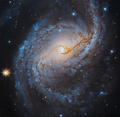Dosya:Stellar Sights in this New Hubble Galaxy Snapshot (Ngc6951-4ok-flat-final).webp

Ebadê verqaytê PNG na dosyay WEBP: 616 × 600 piksel. Agoznayışê bini: 246 × 240 piksel | 493 × 480 piksel | 789 × 768 piksel | 1,052 × 1,024 piksel | 2,103 × 2,048 piksel | 4,075 × 3,968 piksel.
Ebato oricinale (4,075 × 3,968 pikselan, ebatê dosya: 1.99 MB, MIME tipê cı: image/webp)
Verêniya dosya
Seba diyayışê viyarteyê dosya ra tarixê ke qısımê tarix/zemani derê inan bıtıkne.
| Tarix/Zeman | Resımo qıckek | Ebadi | Karber | Mışewre | |
|---|---|---|---|---|---|
| nıkayên | 10:07, 14 Tışrino Peyên 2023 |  | 4,075 - 3,968 (1.99 MB) | C messier | Uploaded a work by NASA's Hubble Space Telescope, ESA, A. Filippenko (University of California - Berkeley), R. Foley (University of California - Santa Cruz), C. Kilpatrick (Northwestern University), and D. Sand (University of Arizona); Processing: Gladys Kober (NASA/Catholic University of America) from https://science.nasa.gov/missions/hubble/stellar-sights-in-this-new-hubble-galaxy-snapshot/ with UploadWizard |
Gurenayışê dosya
The following pages link to this file:
Gurenayışê dosyaya gılovere
Ena dosya wikiyanê binan de gureniyena.
- ar.wikipedia.org sero guriyayış
- arz.wikipedia.org sero guriyayış
- az.wikipedia.org sero guriyayış
- ce.wikipedia.org sero guriyayış
- en.wikipedia.org sero guriyayış
- fa.wikipedia.org sero guriyayış
- tt.wikipedia.org sero guriyayış
- www.wikidata.org sero guriyayış


